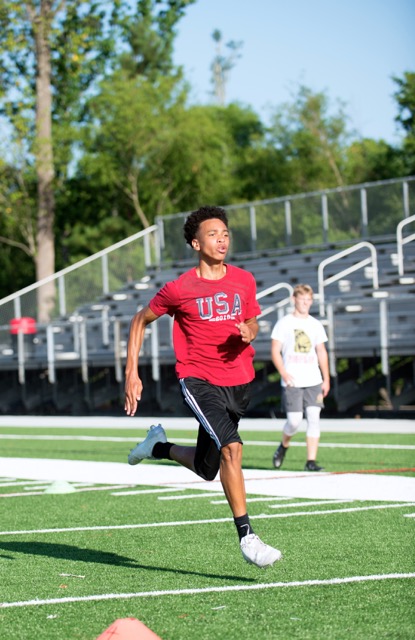Feb 10, 2017Speed Groups
As coaches, one of the major challenges we face is determining how to maximize speed performance in a team setting. Often coaches design programs that address the majority of the athletes. The challenge with this is those that are faster tend to get undertrained, whereas slower athletes tend to get overtrained. Subsequently, the only athletes that really get what they need to improve are those in the middle of the pack. Another challenge is the specific speed quality that should be trained to improve performance may be different for each athlete. For instance, linear speed over short distances can be broken down into three major areas.
1.) Acceleration- 5-20 meters
2.) Top-end speed- 20-40 meters
3.) Speed Endurance- greater than 40 meters or the ability to repeat sprints with minimal loss of speed over a match or competition.
While research shows that all of these variables are related and interrelated they are still distinct qualities and should be trained differently. Thus, to get the most benefits from a speed training program we would aim to improve on deficiencies. For the purpose of this post we will focus on the first two areas: acceleration and top end speed.

One way to divide your athletes based on need is to perform a simple 30-meter sprint test with split times. To perform this test you will need a couple of stopwatches (a testing partner, a measuring tape, a track or large open area, and markers/cones.)
Procedures:
- Begin by marking the starting line with a cone
- Place another cone directly in line with the starting cone at both 10 and 30 meters.
- The athlete should stand behind the starting line in a two or three-point athletic stance depending on their sport.
- If using a stopwatch, one coach should be positioned just to the side of the 10-meter mark and one coach will need to be at the 30-meter mark.
NOTE: While stopwatches can be used, a laser timer can significantly improve the validity and reliability of these tests. Additionally, when pressing the button on the stopwatch the coach should use the index finger, rather than the thumb to improve the accuracy of the measure.
- On the “go” command, or on first movement, the coach will start the stopwatch. The coach positioned at the 10-meter mark (i.e., acceleration time) will stop the stopwatch when the athlete crosses this line, whereas the coach at the 30-meter mark will stop their timer as the athlete crosses the 30-meter mark (e.g., top-end speed). Time to the nearest 0.10 sec should be recorded
- Allow up to three sprints with a minimum of 3-5 minutes’ rest between sprints to allow recovery and minimize the effects of fatigue
- The best time for the 30-meter sprint should be recorded as the individual’s final score (NOTE: Take both 10 meter and 30 meter times for the best score).
Analysis:
Once this information has been collected the coach can then identify which speed attribute(s) (i.e. acceleration or top-end speed) are in most need of improvement. Athletes who have below average acceleration speeds compared to the team, but are above average from the 20-30 meter marks would likely benefit most from training their ability to accelerate in the first 0-10 meters. For athletes who accelerate quickly, then are unable to maintain their speed between 20 to 30 meters, they may benefit from longer distance (20-60 m) sprints. Athletes who fall below the averages in both categories will need to improve both acceleration and top-end speed.
Conclusion:
By determining which speed attributes your players need to develop a coach is better able to design speed training programs to meet the athlete’s individual needs. Furthermore, by classifying athletes into different groups each athlete on the team can truly focus on becoming their personal best rather than being lumped into the middle.
This article was originally published on the website of Elite Sports University (ESU) and is being used with permission from the organization. ESU is an online university that offers the latest scientific courses on strength and conditioning, speed agility, nutrition, and specialty classes for tactical coaches, LTAD, and personal trainers. ESU classes can be taken to fulfill CEU requirements, college credits, or to improve your knowledge base. More information is at: elitesportsuniversity.com.
A major challenge for coaches is determining how to maximize speed performance in a team setting. This author uses a simple test to break athletes into groups and train them accordingly.
Jay Dawes, PhD, CSCS,*D, NSCA-CPT,*D, USAW, FNSCA, is an Assistant Professor of Strength and Conditioning and the head strength coach for women’s soccer at the University of Colorado-Colorado Springs. Jay has worked as a strength/performance coach, educator and post-rehabilitation specialist for over 15 years, and continues to act as a performance consultant for a wide-variety athletes, law enforcement officers and those in physically demanding occupations. Jay was recognized as a Fellow of the NSCA (FNSCA) in 2009.



